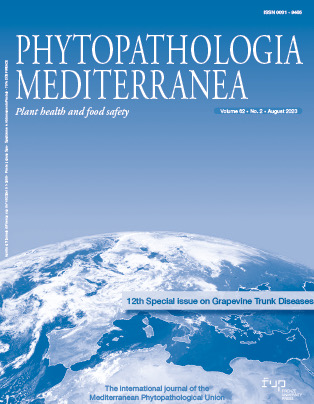Published 2023-09-15
Keywords
- Cylindrocarpon-like fungi,
- grapevine trunk disease,
- Vitis vinifera
How to Cite
Copyright (c) 2023 María Julia CARBONE, Rossana REYNA, Pedro MONDINO, Sandra ALANIZ

This work is licensed under a Creative Commons Attribution 4.0 International License.
Abstract
Black foot is a serious soilborne fungal disease causing decline of young grapevines. Affected plants show brown to dark streaks developing from the rootstock bases, wood necroses at trunk bases, sunken necrotic lesions on roots, and reduced root biomass. Several fungi, commonly known as Cylindrocarpon-like asexual morphs, have been associated with black foot. Nursery vines are infected during rooting in propagation processes, which is important for dissemination of the pathogens. Species associated with black foot in nursery vines produced in Uruguay were characterized by molecular, phenotypical and pathogenicity studies. From 2017 to 2019, 181 rooted vines grafted onto ‘1103P’, ‘SO4’, ‘101-14’, ‘3309C’ or ‘Gravesac’ rootstocks were sampled, and 71 Cylindrocarpon-like fungal isolates were recovered from rootstock tissues (basal ends and roots). Based on multi-gene phylogenetic analyses of HIS3, TEF and TUB2, and supported by phenotypical characterization, five species of Dactylonectria and Ilyonoectria were identified, with D. macrodidyma being the most prevalent followed by D. novozelandica, D. torresensis, D. palmicola and I. liriodendri. Four Ilyonectria isolates could not be identified to species level. Isolate pathogenicity was assessed using healthy rooted ‘Gravesac’ plants. After three months, isolates of all species infected the plants, causing necrotic lesions on roots and reducing root biomass. On average, 39% of ready-to-plant nursery vines were affected by black foot, emphasizing the need to develop integrated management to reduce black foot incidence in Uruguayan grapevine nurseries, based on studies under local conditions.






